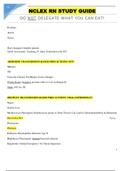92
NCLEX RN STUDY GUIDE
DO NOT DELEGATE WHAT YOU CAN EAT!
Evaluate
Assess
Teach
Don’t delegate Unstable patients Initial Assessment, Teaching, IV drips, Evaluations only RN
AIRBORNE TRANSMISSION-BASED PRECAUTIONS: MTV
Measles
TB
Varicella-Chicken Pox/ Herpes Zoster-Shingles
Private Room: Negative pressure with 6-12 air exchanges/hr
Mask: N95 for TB
DROPLET TRANSMISSION-BASED PRECAUTIONS: Think of SPIDERMAN!
Sepsis
Scarlet fever
Streptococcal Pharyngitis (Streptococcus group A/ Strep Throat): Can Lead to Glomerulonephritis & Rheumatic
Parvovirus B19 Fever.
Pneumonia
Pertussis
Influenza/ Haemophilus influenza type B
Diphtheria (Pharyngeal): Serious bacterial infection.
Epiglottitis: Medial Emergency! No Throat Inspection. 1 92
NCLEX RN STUDY GUIDE
Rubella/ German measles
Mumps
Meningitis/ Neisseria Meningitidis
Mycoplasma/ Meningeal Pneumonia
An - Adenovirus
Private Room or Cohort Surgical mask PRN for Procedures
Mask 3ft Distance
CONTACT PRECAUTION TRANSMISSION-BASED PRECAUTIONS: MRS.WEE
Multidrug resistant organism/ MRSA/ VRE
Respiratory infection
Skin infections Wound infection
Enteric infection - Clostridium Difficile
Eye infection – Conjunctivitis
*MRSA - Contact precaution ONLY. Use Chlorhexidine Wipe!
*VRSA - Contact & Airborne precaution (Private room, door closed, negative pressure)
*SARS (Severe Acute Resp Syndrome) Airborne & Contact (just like Varicella)
SKIN INFECTIONS- VCHIPS- CONTACT
Varicella Zoster
Cutaneous Diphtheria (Bacteria Infection in the Wound)
Herpes Simplex
Impetigo (Bacterial Skin Infection)
Pediculosis (Lice)
Scabies (Itchy Skin condition. Burrowing Trail of the Scabies Mite)
2 92
NCLEX RN STUDY GUIDE
Middle East Respiratory Syndrome (MERS): Viral respiratory illness caused by Coronavirus (MERS-CoV). S/S: Fever, Cough, SOB, and Death. The Incubation Period is 5-6 days but can range from 2-14 days.
CDC: Standard (Gloves), Contact (Gown), Eye Protection (Goggles), Airborne Precautions (N95)
Negative room: Negative disease (TB, Disseminated Herpes Zoster)
Positive room: Protect the Patient (HIV, Cancer) Addison’s= hyponatremia, hypotension, decreased blood vol, hypoglycemia, hyperKalemia, HyperCalcemia.
Cushing’s= HyperNatremia, HyperTension, Incr. Blood Vol, HyperGlycemia, hypokalemia, hypocalcemia.
Managing Stress in a patient with Adrenal Insufficiency ( Addison’s) is paramount, because if the Adrenal glands are stressed further it could result in Addisonian Crisis. Addison’s: Remember BP is the most Important assessment parameter, as it causes Severe Hypotension.
Addison’s: (need to "add" hormone): Hypoglycemia, Dark pigmentation, Decr. Resistance to Stress, fractures, Alopecia, Weight Loss, GI distress. Vitiligo. Mood swings (Normal)
Need to Report S/S of Infection/ Fever (Addisonian Crisis)
Tx: Mineral Corticoids.
Addisonian Crisis: Hypoglycemia, Confusion, n/v, Abd Pain, Extreme Weakness, Dehydration, Decr. BP. Cushings: (have extra "Cushion" of Hormones): Hyperglycemia, prone to Infection, Muscle Wasting, Weakness, Edema, HTN, Hirsutism, Moonfaced/Buffalo Hump
Cause: Excessive production of Corticotropin (Hyperplasia of the Adrenal Cortex) & Cortisol-secreting Adrenal Tumor.
Prednisone Toxicity: Cushing’s syndrome- Buffalo Hump, Moon face, Hyperglycemia, Hypertension.
Acetaminophen: 10-20. Max 4000mg per day.
3 92
NCLEX RN STUDY GUIDE
Acetaminophen Poisoning: Possible Liver Failure for about 4 days. Close observation required. Tx: (Antidote) n-AcetylCysteine/Mucomyst AcetylSalicyclic Acid (ASA): Metabolic Acidosis.
S/S: Tinnitus, Coffee Ground Emesis (Old Blood), Black tarry stools (Melena), Bruising, Tachycardia, Hypotension, GI Ulcers.
Tx: Activated Charcoal, then IV Na+ Carbonate. Acromegaly: Coarse Facial feature. Assess Cardiac Problems (eg. S3, S4).
Acute Respiratory Distress Syndrome (ARDS): The 1st Sign is Incr. Respirations. Later comes Dyspnea, Retractions, Air Hunger, Cyanosis.
Cardinal sign is Hypoxemia (Low O 2 level in tissues).
Refractory Hypoxemia is the hallmark of ARDS, a progressive form of acute respiratory failure that has a high Mortality rate. It can develop following a Pulmonary Insult (eg, aspiration, pneumonia, toxic inhalation) or nonpulmonary insult (eg, sepsis, multiple blood transfusions, trauma) to the Lung.
The Inability to improve Oxygenation With Incr. in O2 concentration.
The insult triggers a Massive Inflammatory response that causes the lung tissue to release inflammatory mediators (leukotrienes, proteases) that cause damage to the alveolar-capillary (A-C) membrane. As a result of the damage, the A-C membrane becomes more permeable, and intravascular fluid then leaks into the alveolar space, resulting in a Noncardiogenic Pulmonary Edema.
The lungs become Stiff and Noncompliant, which makes Ventilation and Oxygenation less than optimal and results in increased work of breathing, tachypnea and alkalosis, atelectasis, and refractory hypoxemia. ARDS (fluids in alveoli), DIC (Disseminated Intravascular Coagulation) are always Secondary to something else (another disease process). – Impaired Gas Exchange. PreOxygenated with 100% O2, and Suction should be applied for no more than 10 seconds to prevent hypoxia. The nurse must wait 1-2 minutes between passes to ventilate to prevent hypoxia. 4




